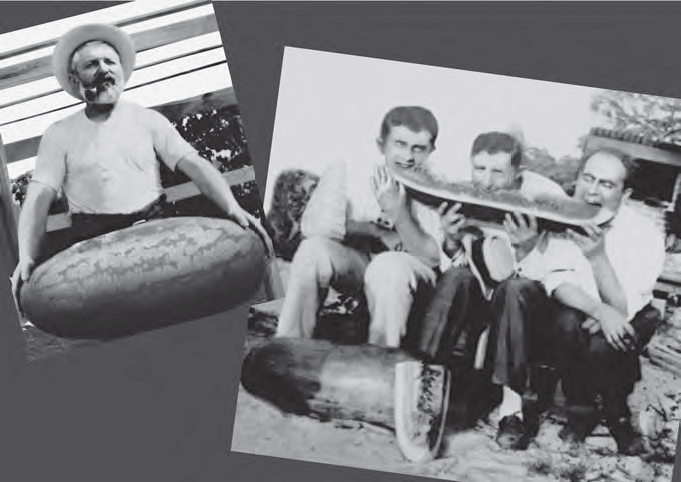 L-R: Moses Levy (left, holding whole watermelon) and his sons Aaron Harry, Saul and Eddy Levy taste the fruit from their farm that won first prize as the largest watermelon at the State Fair, c. 1915.
L-R: Moses Levy (left, holding whole watermelon) and his sons Aaron Harry, Saul and Eddy Levy taste the fruit from their farm that won first prize as the largest watermelon at the State Fair, c. 1915.
Beginning in 1912, several families began a migration from Pittsburgh, PA, to Orlando. Moses and Sarah Levy were among the first to arrive. They purchased 24 acres at Edgewater Drive and Princeton in today’s College Park. Regular Sabbath and High Holiday services were observed there, filling both the religious and social needs of the early residents. The Jews in the area arrived by foot and horseback, and after Yom Kippur eve prayers, they slept in the rooms and on the veranda of the Levy house.
Dan Levy
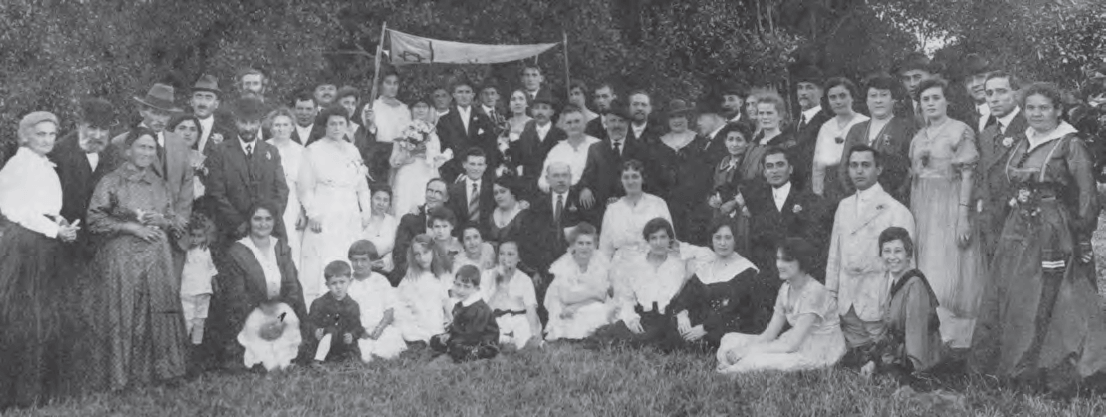 The wedding of Rose Gleibman and Aaron Harry Levy took place in the Levy grove, 1917.
The wedding of Rose Gleibman and Aaron Harry Levy took place in the Levy grove, 1917.
Rose Gleibman emigrated from Russia to New York. She came to Orlando to live with her sister Rifka Isen and met Aaron Harry Levy. They married under the chuppah (wedding canopy) at the site of his father’s orange grove. The entire Jewish community attended with orange blossoms in the air. Note the Zionist flag crafted as the chuppah.
Collections of the Jewish Museum of Florida-FIU, originated by Marcia Jo Zerivitz, LHD, Founding Executive Director
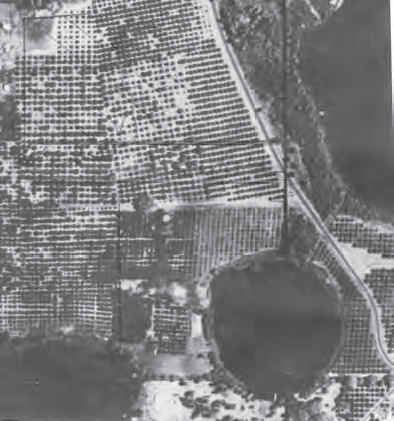 Aerial photo of Peter Wittenstein’s land in College Park, c. 1955.
Aerial photo of Peter Wittenstein’s land in College Park, c. 1955.
Peter David Wittenstein and his family migrated from Russia via Argentina to Pittsburgh, PA, in 1898. In Russia, he was a sofer, lay religious leader, shochet and mohel. In l912, Peter, his wife Bella and son Morris relocated to Orlando
and cultivated a sweet potato farm, then planted a grove. He also raised cows to be slaughtered for kosher meat.
Daniel Wise
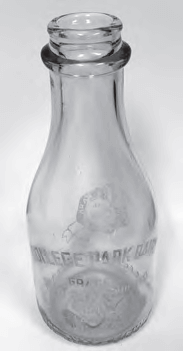 Milk bottle from Morris Wittenstein’s College Park Dairy, 1927.
Milk bottle from Morris Wittenstein’s College Park Dairy, 1927.
In 1912, Morris married his former Pittsburgh, PA, neighbor Esther Shader. They purchased property between Lake Silver and Lake Fairview where Morris operated the College Park Dairy with 60 cows. He served milk products to schools and hospitals and processed milk from other dairies. As a founder of the Chevra Kadisha, Morris contributed much to the Jewish community. Morris and Esther had four children: Joseph, Florence [Tobias], Neil and Tybe [Kahn].
Collections of the Jewish Museum of Florida-FIU, originated by Marcia Jo Zerivitz, LHD, Founding Executive Director
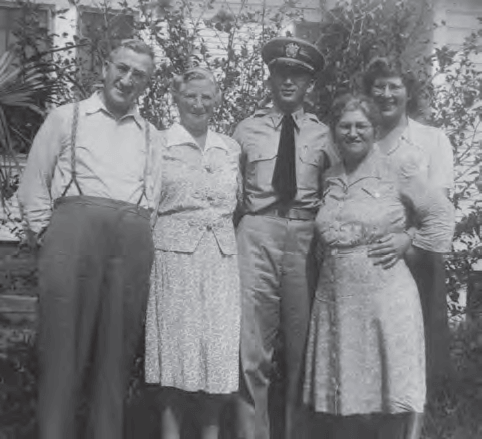 Morris Wittenstein family at home, 1943.
Morris Wittenstein family at home, 1943.
L-R: Morris, Bertha Fraiberg, Joseph (in US Navy uniform), Esther and Florence.
Collections of the Jewish Museum of Florida-FIU, originated by Marcia Jo Zerivitz, LHD, Founding Executive Director
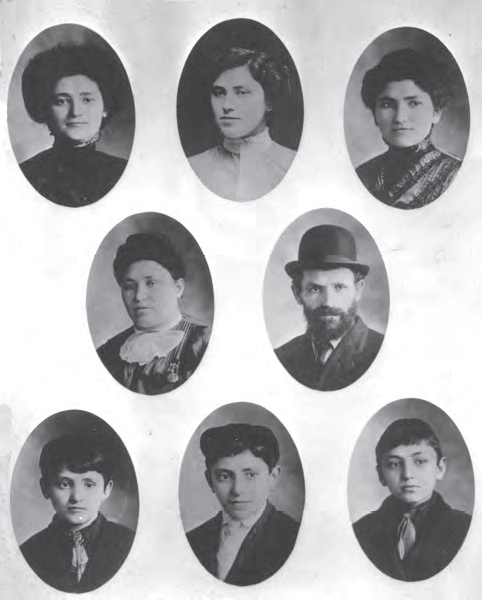 Shader family members are pillars of the Orlando Jewish community, 1913.
Shader family members are pillars of the Orlando Jewish community, 1913.
Israel Shader, born in Russia, immigrated to Pittsburgh, PA. Rose and Israel Shader followed their daughter Esther to Orlando with their sons Isadore, Myer and Ben to start a grove and farm. Israel came seeking a place where he could follow tradition. He brought the first Torah that was used for services in the Levy grove. Prior to Saturdays (the Jewish Sabbath), a large oven was filled with food so that no cooking was done on the holy day. Top row: Fannie, Sarah, Esther; center row: Rose and Israel; bottom row: Ben, Myer and Isadore
Collections of the Jewish Museum of Florida-FIU, originated by Marcia Jo Zerivitz, LHD, Founding Executive Director
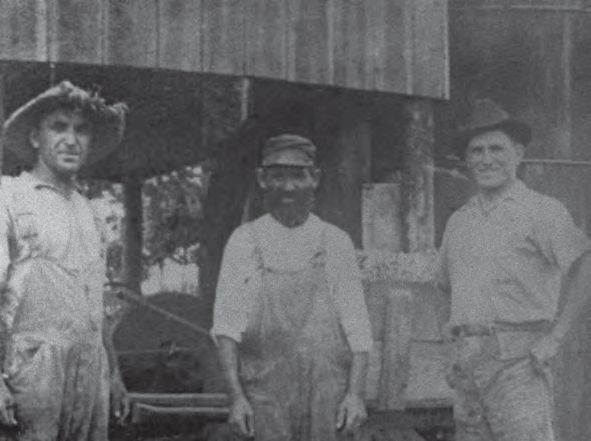 Until 1949, L-R: Myer, Israel and Isadore Shader operated the family farm, c. 1916.
Until 1949, L-R: Myer, Israel and Isadore Shader operated the family farm, c. 1916.
In 1913, Israel Shader started a dairy with 15 Jersey cows. The Shader farm grew through the years to have a main house, a second house that had been an old chicken house where the maid and her husband lived, and three others where the dairy hands lived. It consisted of 80 acres of land and 100 head of cattle. Eighty of the cows were milked, another 20 were heifers. Gentile neighbors milked the cows on the Sabbath and Jewish holidays. Thirty-eight acres were set aside for citrus.
Collections of the Jewish Museum of Florida-FIU, originated by Marcia Jo Zerivitz, LHD, Founding Executive Director
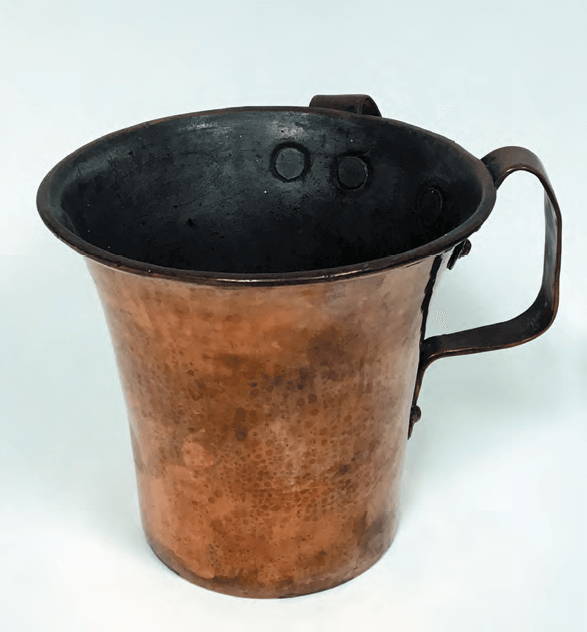 Israel Shader followed tradition by saying a blessing when he used this two-handled ritual washing pitcher before eating a meal, c. 1900.
Israel Shader followed tradition by saying a blessing when he used this two-handled ritual washing pitcher before eating a meal, c. 1900.
The left hand of the pitcher holds one handle and pours water three times over the right hand. Then the right hand, using the other handle, pours water three times over the left hand. Using two handles ensures that the hand that has been rinsed does not come into contact with the hand that is still unclean. Israel Shader brought this to Orlando, where he continued to use it. Shader, an Orthodox Jew, never joined the local synagogue, Ohev Shalom, instead returning to Pittsburgh every year for the High Holidays of Rosh Hashanah and Yom Kippur.
Collections of the Jewish Museum of Florida-FIU, originated by Marcia Jo Zerivitz, LHD, Founding Executive Director
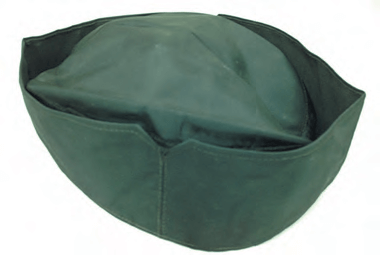 Israel Shader wore a kippah to show
Israel Shader wore a kippah to show
respect for God, c. 1900.
Israel Shader was a deeply religious Jew who observed all the traditions of the faith.
Collections of the Jewish Museum of Florida- FIU, originated by Marcia Jo Zerivitz, LHD, Founding Executive Director
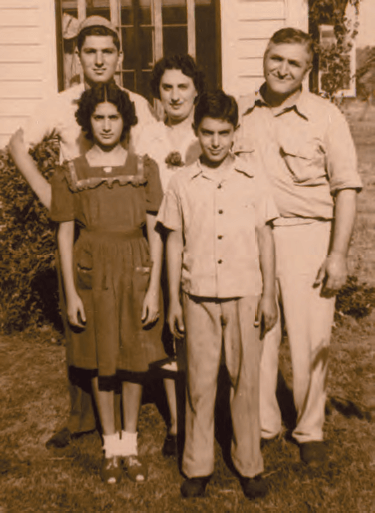 Ben Shader was a family man, 1943.
Ben Shader was a family man, 1943.
In 1922, Ben Shader married Bessie Joseph. They are shown here with children Stanley, Edythe and Ronald. Charles is not in this photo. All of Ben’s siblings continued to live in Orlando with their spouses. They were Jacob and Fannie Meitin, George and Sarah Miller, Morris and Esther Wittenstein, Isador and Gittle Shader and Myer and Beatrice Shader. Several of the third and fourth generations of the Shader and Wittenstein families are well known in the area and the fifth generation is growing in numbers.
Collections of the Jewish Museum of Florida- FIU, originated by Marcia Jo Zerivitz, LHD, Founding Executive Director
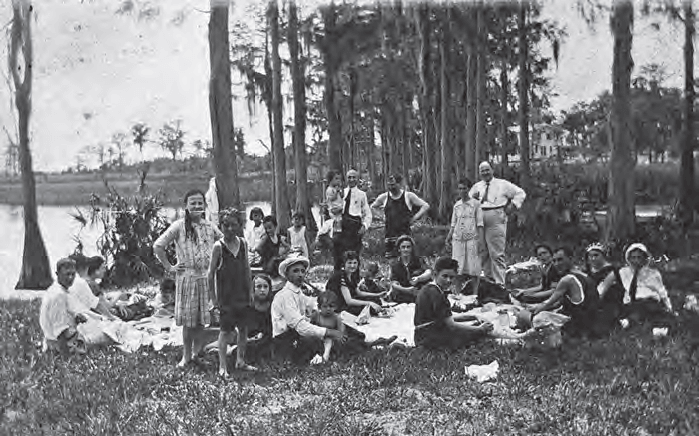 On the Shader’s vast property on the shores of Lake Fairvilla, members of the Jewish community gathered for a picnic—kosher, of course, c. 1920.
On the Shader’s vast property on the shores of Lake Fairvilla, members of the Jewish community gathered for a picnic—kosher, of course, c. 1920.
According to Tybe Wittenstein Kahn, when Sunday school was over for the year, there was a picnic. Sometimes it was at the Shader Farm on Lake Fairvilla. Other times they went to Lakeside (now Pine Castle) and went swimming, ran races and played all kinds of sports.
Collections of the Jewish Museum of Florida-FIU, originated by Marcia Jo Zerivitz, LHD, Founding Executive Director
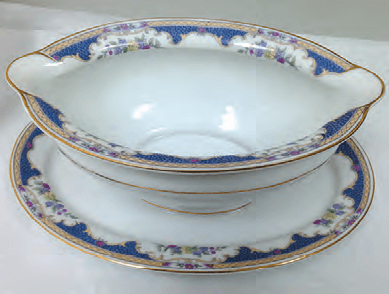 Bessie Shader used this gravy boat on the family farm, 1930s.
Bessie Shader used this gravy boat on the family farm, 1930s.
The large Shader family gathered for many meals on their farm in Fairvilla. Bessie kept a kosher home and used this item from a set of china saved for special occasions.
Collections of the Jewish Museum of Florida-FIU, originated by Marcia Jo Zerivitz, LHD, Founding Executive Director
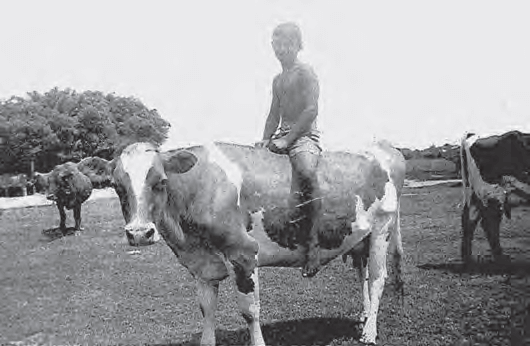 Ride ’em “Cow”boy! 1945.
Ride ’em “Cow”boy! 1945.
At the age of 12, Ron Shader named his favorite cow, Bessie. Yes, the same name as his mother! Parties for teens were often held in the Shader barn. Ron recalls the time he turned cows loose and they ended up on the dance floor, creating a lot of chaos “and all the girls screamed.”
Collections of the Jewish Museum of Florida-FIU, originated by Marcia Jo Zerivitz, LHD, Founding Executive Director
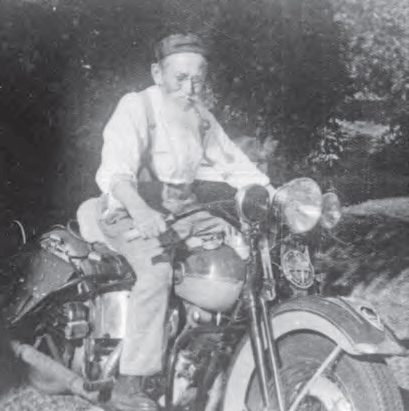 Israel Shader “tooling around” the Shader farm on grandson Neil Wittenstein’s motorcycle, 1950.
Israel Shader “tooling around” the Shader farm on grandson Neil Wittenstein’s motorcycle, 1950.
Shader Road, which intersects both John Young Parkway and the Orange Blossom Trail, was named for Israel Shader and is a reminder that the family farm was located in this area.
Collections of the Jewish Museum of Florida-FIU, originated by Marcia Jo Zerivitz, LHD, Founding Executive Director
 Shader sisters pose with some offspring, 1917.
Shader sisters pose with some offspring, 1917.
Fannie Shader and her husband Jacob Meitin came to Orlando in 1917. Sarah Shader and her husband George Miller came around 1921. Back row: Esther Wittenstein, Fannie Meitin and Sarah Miller; front row L-R: Ruth Meitin, Joseph Wittenstein, Ralph Meitin and Lilli Ann Miller [Meier]
Collections of the Jewish Museum of Florida-FIU, originated by Marcia Jo Zerivitz, LHD, Founding Executive Director
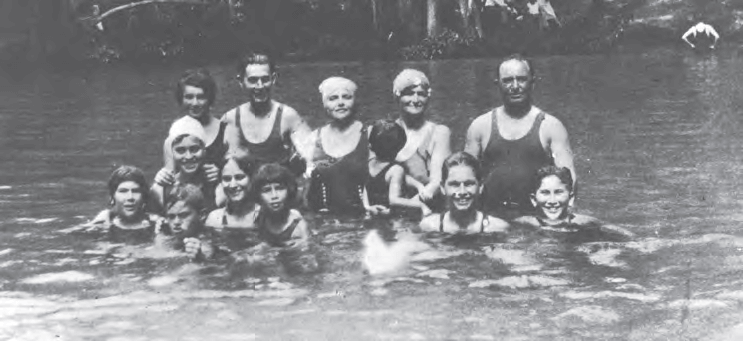 The Meitin and Wittenstein families cool off in Wekiva Springs, 1926.
The Meitin and Wittenstein families cool off in Wekiva Springs, 1926.
Included here are Florence Wittenstein [Tobias] (front row, far left), Tybe Wittenstein [Kahn] (front, fifth from left), Joe Wittenstein (front, far right), Evelyn Meitin (back row, far left), Fannie Meitin (back row, second from right) and Jacob Meitin (back row, far right).
Collections of the Jewish Museum of Florida- FIU, originated by Marcia Jo Zerivitz, LHD, Founding Executive Director
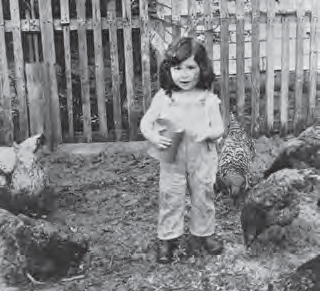 Jonas Cohen’s daughter Hilda [Saperstein] surrounded by chickens prior to their kosher slaughter by Jonas, c. 1918.
Jonas Cohen’s daughter Hilda [Saperstein] surrounded by chickens prior to their kosher slaughter by Jonas, c. 1918.
Part of the Pittsburgh migration, Cohen married Yetta Levine in 1916 and opened Orlando’s first kosher butcher shop, within a downtown fancy grocery store owned by Joseph Barbanel. To be kosher, poultry and meat must be slaughtered in a very specific manner according to Jewish law. Cohen had been trained in Pittsburgh to be a shochet.
Collections of the Jewish Museum of Florida-FIU, originated by Marcia Jo Zerivitz, LHD, Founding Executive Director
